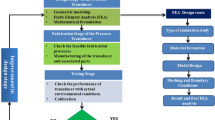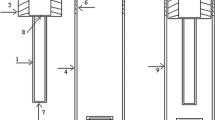Abstract
A tube that can accurately measure small strains and pressure profiles during flow of non-Newtonian paste explosives has been designed and strain gaged. Equiangular rosette strain gages were installed along the length of a 6-mm-diam, 0.46-m-long thin-walled aluminum tube. The rosettes were oriented in the classical stress-gage configuration to measure circumferential stress and, hence, internal pressure independent of other stresses.
The tube was static calibrated on a floating-piston pressure calibrator. Steady flow calibration was accomplished by extruding a viscous Newtonian silicone oil. Inlet pressure ranged from 0.52 to 2.1 MPa (75 to 300 psi). For the low-pressure 0.52-MPa silicone-oil extrusion, the full-scale strain levels varied from 6 to 53 μm/m. For all eight strain-gage stations, the maximum deviation from a linear pressure profile was equivalent to 0.5 μm/m. A pulsed-current-excitation signal-conditioning and digital data-acquisition system provided the necessary stability and precision to measure these unusually low-strain levels accurately.
Similar content being viewed by others
References
Tovey, F. Michael, “Material Properties in the Design of Transducer Flexures,” Proc. Western Regional Strain Gage Committee, SESA (Sept. 20–21, 1971).
Weinstein, Warren D., “Microperformance of Metals,”Machine Design,41 (28),174–181 (Dec. 11,1969).
Kern, Robert E., “The Stress Gage,”Proc. SESA,4 (1),124 (1946).
Perry, C.C. andLissner, H.R., The Strain Gage Primer, McGraw Hill, New York (1955).
Murray, W.M., “Some Simplifications in Rosette Analysis,”Proc. SESA,15 (2),39 (1958).
Flynn, Paul D., “Strain-gage Instrumentation for Ammunition Testing,”Experimental Mechanics,15 (5),192 (May 1975).
Dittbenner, Gerald R., “The Application of Strip Strain Gages for Measuring Residual Stresses in Beryllium,” Proc. Third SESA Int. Conf. Experimental Mechanics, Los Angeles, CA (May 13–18, 1973).
Freynik, H.S., Jr. andDittbenner, G.R., “Strain-gage-stability Measurements for Years at 75°C in Air,”Experimental Mechanics,16 (4),155 (Apr. 1976).
Liston, D.H., “Pulsed Strain Gage Excitation and Digital Data Acquisition—A Winning Combination,” Proc. Western Regional Strain Gage Committee, SESA (Aug. 20–21, 1973).
Author information
Authors and Affiliations
Rights and permissions
About this article
Cite this article
Freynik, H.S., Dittbenner, G.R. Measuring small internal pressures along a tube during steady flow. Experimental Mechanics 17, 415–419 (1977). https://doi.org/10.1007/BF02324238
Issue Date:
DOI: https://doi.org/10.1007/BF02324238




